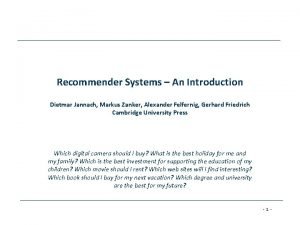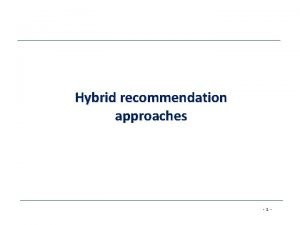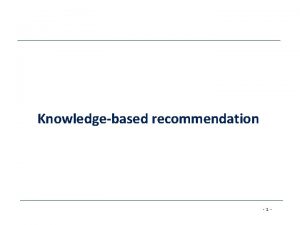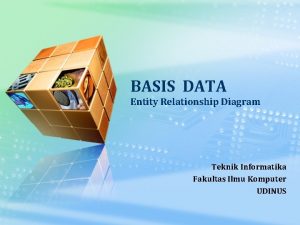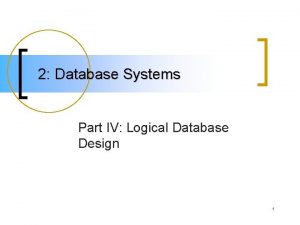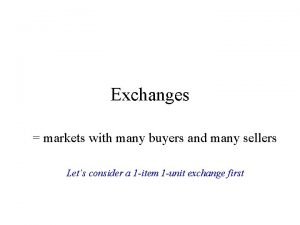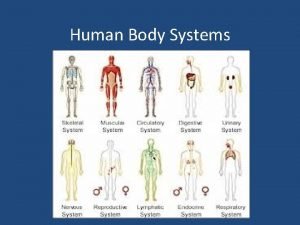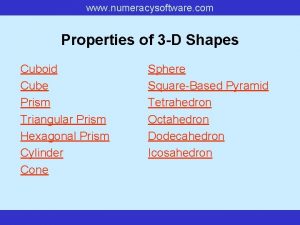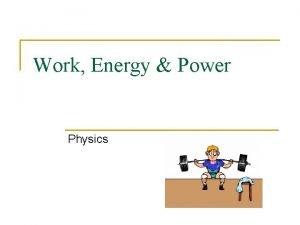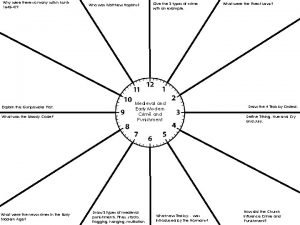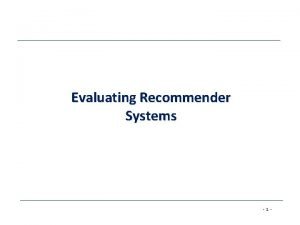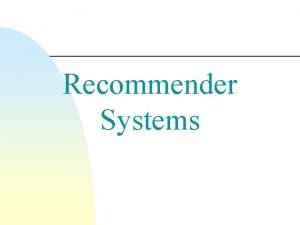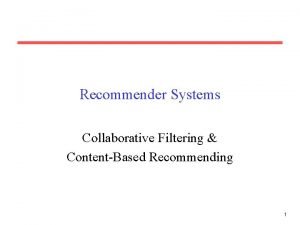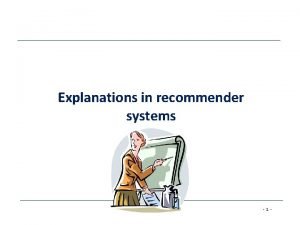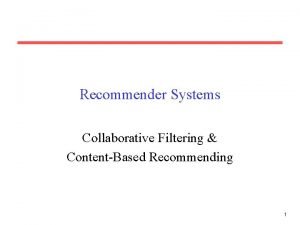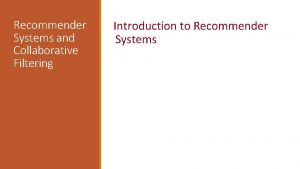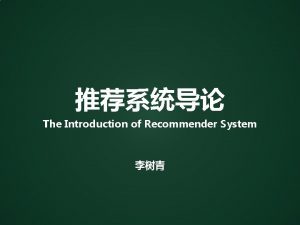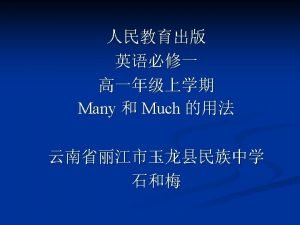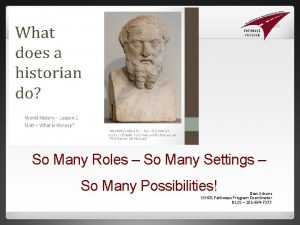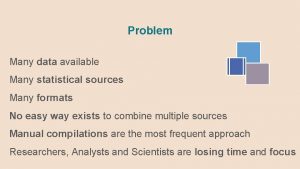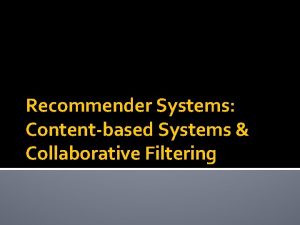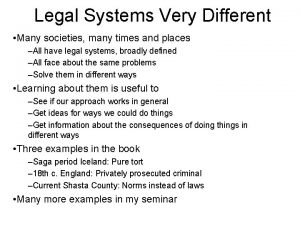Recommender Systems Recommender Systems n n In many


































- Slides: 34

Recommender Systems

Recommender Systems n n In many cases, users are faced with a wealth of products and information from which they can choose. To alleviate this many web sites help users by using Recommender Systems, List of items or page that are likely to interest them ¨ Once the user makes a choice, a new list can be presented ¨

What Data is used to make the recommendations? n Explicit feedback Ratings ¨ Reviews ¨ Auctions ¨ • Implicit feedback Page visits ¨ Purchase data ¨ Browsing paths ¨

What are the type of recommendations? n Item-to-Item associations Similar pages this ¨ “Users who bought this book also bought X” ¨ n User-to-User associations ¨ n Which other user has similar interests? User-to-Item associations ¨ Rating history describes user ¨ Items are described by attributes ¨ Items are described by ratings of other users

Classification of Recommender Systems n Content-based approach ¨ Item is described by a set of attributes n Movies: e. g director, genre, year, actors n Documents: bag-of-words ¨ Similarity items n ¨ metric defines relationship between e. g. cosine similarity Examples n n “related pages” in search engine Google News

Related Approaches Mooney and Roy (2000) ¨ Their approach comes from the Information Retrieval (IR) field ¨ They rely on the content of the items, and use some similarity score to match the items based on their content n Burke (2000) ¨ The use the content-based recommendation. ¨ However, they allow to the user introduce explicit information about his preferences.

Types of Recommender Systems n Collaborative filtering ¨ Item is described by user interactions ¨ Matrix V of n (number of users) rows and m (number of items) columns ¨ Elements of matrix V are the user feedback ¨ Examples: n n n Rating given to item by each user Users who viewed this item Similarity metric between items

Related Approaches Collaborative Filtering ¨ They used historical data gathered from other users to make the recommendation n Ex: If a user wants to rent a movie, he tends to rely on friends to recommend him items that they have like it ¨ The goal is to identify those users whose taste in recommendations is predictive of the taste of a certain person and use this recommendations to construct an interesting list for the user.

Collaborative Filtering Models n Memory Based ¨ Neighborhood ¨ Latent n Models Factors Model Based ¨ Classification ¨ Bayesian Networks ¨ Association Rules

Memory Based Approaches ¨ Works directly with the user data ¨ Given a user, the system finds the most similar users to make a recommendation ¨ There are two approaches: Neighborhood n Latent Factor n

Neighborhood Approach n n It’s an item-oriented approach, focusing on evaluating the preference of a user to an item based on ratings of similar items by the same user. Users are transformed to item space by viewing them as baskets of rated items. No longer to compare users to items, but directly relate items to items. Pros: rely on a few significant neighborhood relations; effective at detecting very localized relationships Cons: ignore the vast majority of ratings by a user; unable to capture the totality of weak signals in all of a user’s rating.

Latent Factor Models n Transform both items and users to the same latent factor n n n 1 3 5 2 4 2 5 4 1 4 4 1 space, thus making them directly comparable. Latent space tries to explain ratings by characterizing both products and users on factors automatically inferred from user feedback. Pros: effective at estimating overall structure that relates simultaneously to most or all items. Cons: poor at detecting strong association among a small set of closely related items. 3 4 2 3 5 4 3 4 4 2 1 3 5 ~ 2 2 2 3 4 5 . 1 -. 4 . 2 -. 5 . 6 . 5 -. 2 . 3 . 5 1. 1 2. 1 . 3 -. 7 2. 1 -2 -1 . 7 . 3 1. 1 -. 2 . 3 . 5 -2 -. 5 . 8 -. 4 . 3 1. 4 2. 4 -. 9 -. 8 . 7 . 5 1. 4 . 3 -1 1. 4 2. 9 -. 7 1. 2 -. 1 1. 3 2. 1 -. 4 . 6 1. 7 2. 4 . 9 -. 3 . 4 . 8 . 7 -. 6 . 1

Singular Value Decomposition n n Decompose ratings matrix, R, into coefficients matrix U and factors matrix V such that is minimized. U = eigenvectors of RRT (Nx. N) V = eigenvectors of RTR (Mx. M) = diag( 1, …, M) eigenvalues of RRT

Challenges Collaborative Filtering User Cold-Start problem not enough known about new user to decide who is similar (and perhaps no other users yet. . )

Challenges Collaborative Filtering n Sparsity when recommending from a large item set, users will have rated only some of the items (makes it hard to find similar users)

Challenges Collaborative Filtering n Scalability with millions of users and items, computations become slow n Item Cold-Start problem Cannot predict ratings for new item till some similar users have rated it [No problem for content-based]

Related Approaches Srebro & Jaakkola (2003) Weighted SVD n Binary weights ¨ wij = 1 means element is observed ¨ wij = 0 means element is missing n Positive weights ¨ weights are inversely proportional to noise variance ¨ allow for sampling density e. g. elements are actually sample averages from counties or districts

Related Approaches SVD with Missing Values Uses Expectation maximization to calculate the approximation of matrix ¨E step fills in missing values of ranking matrix with the low-rank approximation matrix ¨ M step computes best approximation matrix in Frobenius norm ¨ Local minima exist for weighted SVD

Related Approaches Agarwal (2009) Regression-Based Latent Factor Models They presented a regression based factor model that regularizes and deals with both cold-start and warmstart in a single framework. It takes advantage of other user ratings, item and user features to predict the missing ratings

Model Based Approaches ¨ User data is compressed into a predictive model ¨ Instead of using ratings directly, develop a model of user ratings ¨ Use the model to predict ratings for new items ¨ To build the model: Bayesian network (probabilistic) n Clustering (classification) n Rule-based approaches (e. g. , association rules between co-purchased items) n

Related Approaches Stern(2009) Large Scale Online Bayesian Recommender Integrates Collaborative Filtering with Content information. ¨ Users and items compared in the same space. ¨ Flexible feedback model. ¨ Bayesian probabilistic approach. ¨

Value of the Recommendation Many considerations are taken into account to build the list of recommendations: ¨ The likelihood of a recommendation to been accepted by the user ¨ The immediate value to the site ¨ The long term implications of the recommendations on the user’s future choices

Value of the Recommendation Example: Suggest a video camera with probability 0. 5 or a VCR with a probability 0. 6 ¨ To recommend the video camera is less profitable than the VCR ¨ It the long term it might be more profitable (the camera has accessories that are likely to be purchased whereas the VCR does not)

Sequential Nature of Recommendation Process The recommender system suggests items to the user The user can accept or not one the items offered A new list of items is calculated based on the user past ratings

Markov Decision Process (MDP) n A MDP is a model for stochastic decision problems ¨A MDP is a four-tuple (S, A, Rwd, tr) where S is a set of states, A is a set of actions, Rwd is the reward associated with each state/action and tr is the transition function for each state. n n The goal is to behave in order to maximize the total reward The optimal solution π is a policy specifying which action to perform in each state.

Markov Decision Process (MDP) The value function V of the policy π is defined as: Where γ is a discount factor And the optimal value function V* is defined as:

Markov Decision Process (MDP) n To find the optimal policy π* and its corresponding value function V*: ¨ We search the space of the possible policies starting with an initial policy π0(s) ¨ At each step we compute the value function based on the former policy and update the policy based on the new value function

Temporal Dynamics in the Recommendations n Item-side effects: ¨ Product perception and popularity are constantly changing ¨ Seasonal patterns influence items’ popularity n User-side effects: ¨ Customers ever redefine their taste ¨ Transient, short-term bias; anchoring ¨ Drifting rating scale ¨ Change of rater within household

Temporal dynamics - challenges n n n Multiple sources: Both items and users are changing over time Multiple targets: Each user/item forms a unique time series Scarce data per target Inter-related targets: Signal needs to be shared among users – foundation of collaborative filtering cannot isolate multiple problems

Time Sensitive Recommenders Koren (2009) Collaborative Filtering with Temporal Dynamics n He use factor models to separate different aspects of the ratings to observe changes in: Rating scale of individual users 2. Popularity of individual items 3. User preferences 1.

Recommender Systems with Social Networks Use the interaction of the user with others to do recommendations n Motivation: n ¨ Social Influence: users adopt the behavior of their friends n Challenges: ¨ How do we define influence between users?

Recommender Systems with Social Networks Preliminary Approaches Jamali & Ester (2009) Trust. Walker: A Random Walk Model for Combining Trust-based and Itembased Recommendation ¨ Explores the trust network to find Raters. ¨ Aggregate the ratings from raters for prediction. ¨ Different weights for users

Open Challenges n Transparency ¨ ¨ ¨ n Exploration versus Exploitation ¨ ¨ n Convince a user to accept a recommendation Help a user make a good decision Help a user fit a goal or mood Cold start problems (for new items, and for new users) Choosing what questions to ask users Trade-off between optimizing for this user vs. for all users How can meta-data on user or item help? Guided Navigation ¨ ¨ Providing a guide over a vast body of content User's intent detection

Open Challenges n Time Value ¨ Does value of user input decay with time? ¨ Do items change in relevance with time? ¨ How to adjust for recent user experience? n n n Evaluation of the recommenders performance Scalability Combining Content and Collaborative Recommenders efficiently
 Introduction to recommender systems
Introduction to recommender systems Markus zanker
Markus zanker Weighted hybrid recommender systems
Weighted hybrid recommender systems Latent factors recommender system
Latent factors recommender system Knowledge based recommendation
Knowledge based recommendation Many sellers many buyers
Many sellers many buyers E r diagram
E r diagram Bookstore database design
Bookstore database design Are the glue that holds the entities in the erd
Are the glue that holds the entities in the erd Unary many to many
Unary many to many Contoh erd one to one
Contoh erd one to one Unary many to many
Unary many to many Many to many communication
Many to many communication Sqlbi many to many
Sqlbi many to many Ternary relationship database
Ternary relationship database Many sellers and many buyers
Many sellers and many buyers All the body systems
All the body systems Pure command system
Pure command system How many economic systems are there
How many economic systems are there How many types of farming systems are there
How many types of farming systems are there Decision support systems and intelligent systems
Decision support systems and intelligent systems Principles of complex systems for systems engineering
Principles of complex systems for systems engineering Embedded systems vs cyber physical systems
Embedded systems vs cyber physical systems Engineering elegant systems: theory of systems engineering
Engineering elegant systems: theory of systems engineering Cuboid has how many sides
Cuboid has how many sides 11 sentence paragraph template
11 sentence paragraph template What does a multi paragraph essay look like
What does a multi paragraph essay look like Compounds mixtures and elements worksheet
Compounds mixtures and elements worksheet How many types of energy
How many types of energy How many bones are in your hand
How many bones are in your hand Destilbe
Destilbe How to cite many authors
How to cite many authors The ultimate source of energy is
The ultimate source of energy is How many names does allah have
How many names does allah have Different kinds of love
Different kinds of love

